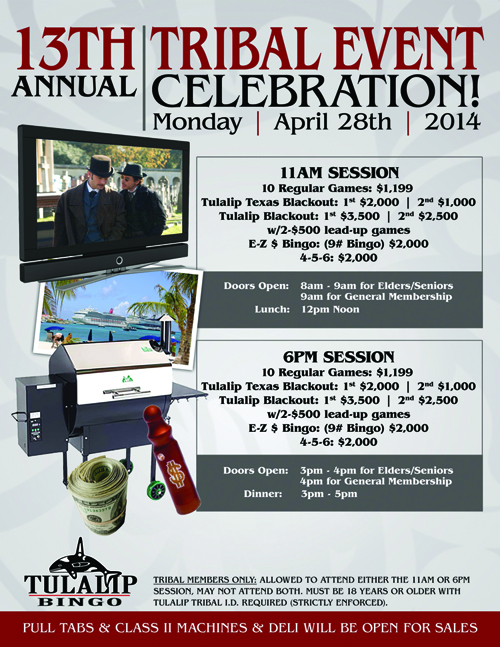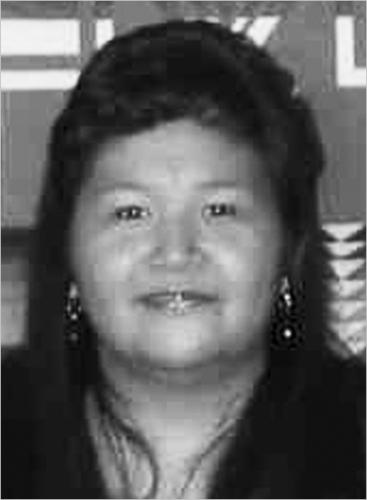Author: Kim Kalliber
Early numbers show devastating toll of mudslide
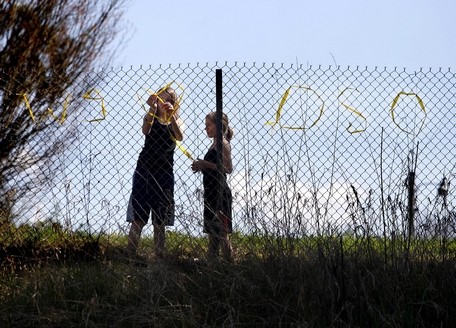
Ava Yeckley and Darby Morgan, both of Arlington, put up a sign Tuesday reading “We heart Oso” on Highway 530.
By Jerry Cornfield and Amy Nile, The Herald
OLYMPIA – The deadly March 22 Oso mudslide and subsequent flooding have caused at least $32.1 million in damage to public infrastructure, according to preliminary assessments by state and federal authorities.
Gov. Jay Inslee cited that figure Tuesday in a letter sent to President Barack Obama asking for federal assistance for local and tribal governments to help cover an array of costs incurred in clearing debris and repairing roads and waterways damaged by the disaster.
The slide not only wiped out the Steelhead Drive neighborhood, it has blocked the usual route into Darrington along Highway 530.
“The landslide and upstream flooding it caused brought down death and destruction on these tight-knit communities in Snohomish County,” Inslee said in a statement. “These are our friends and neighbors and we’re racing to help repair their roads and other public facilities in the Stillaguamish Valley. If the president acts on this request, we can help do the job even faster.”
Also late Tuesday, medical examiners said they had received the remains of 28 slide victims and have identified a total of 22. The names released today were: Brandy Ward, 58, Thom Satterlee, 65, Lon Slauson, 60 and Adam Farnes, 23.
The confirmations lowered the total of missing by two; 20 people still are presumed missing as a result of the slide.
On Monday, Inslee requested the president issue a Major Disaster Declaration to free up federal assistance for individuals, households and businesses affected by the disaster. This could include money for temporary housing and immediate needs, and unemployment insurance benefits.
In that letter, he pointed out 40 homes were destroyed and up to 30 families left in need of long- and short-term housing. It pegged the estimated damage to residences and structures at $10 million.
Inslee wants the president to make two public assistance programs available in Snohomish County, and to the Sauk-Suiattle, Stillaguamish and Tulalip Indian Tribes.
The slide buried 6,000 feet of Highway 530. About 700 feet had been cleared by Tuesday.
Travis Phelps, a spokesman for the state Department of Transportation, said it is too soon to know the highway’s condition.
“There is still a lot of Highway 530 under a lot of mud,” he said. “I am sure we are going to find portions that are damaged and portions that are OK. It is too soon to tell if it is completely demolished.”
The expanse of the Oso mudslide miniaturizes people and their machines.
The workers tasked with clearing the 1.2-square-mile debris field are comparing the devastation to 9/11.
“When you get down there, it looks like the World Trade Center,” said Ed Troyer, of the Pierce County Sheriff’s Office. “Instead of steel workers, it’s loggers.”
Gerry Bozarth, a debris specialist for Spokane Emergency Management, said the tangle in Oso is as complex as that from the terrorist attacks in New York.
Bozarth said searchers may never find all of the victims. The questions families have may never be answered.
Crews continued to search for the missing Tuesday. Some 600 yellow-and-orange-clad workers donned their hard hats. They were looking through piles of hazardous material sometimes 80 feet deep.
Crews are scratching the surface of the debris field, targeting the places they believe people most likely are buried. There are splintered trees, tires, shredded roof tops, pipes, chunks of walls and people’s photos strewn in the muck.
Water that earlier flooded a portion of the site on the southwest corner is now mostly gone.
“People were thinking air pockets, but there were no air pockets,” Troyer said.
Search conditions have improved since the first few days when crews spent much of their time fighting the water.
“It created a hazardous material soup that was exhausting to crews,” Bellevue Fire Lt. Richard Burke said. “They were sinking to their chests in this muck.”
While pumps droned constantly, moving the water out, crews weren’t hauling dirt away.
The contaminated soil is shoveled, sorted for people’s belongings, then piled up. Right now, it is not being moved off site.
Workers and search dogs must go through a decontamination process before leaving to limit the risk of spreading diseases such as dysentery.
On Tuesday, a sour smell rose from the site. It seemed to be a combination of spilled septic tanks, fuel, household products and exhaust from heavy machinery
The operation is much more organized nearly a dozen days after the slide, officials said. Soldiers and others have stepped in, relieving some of the weary workers.
“We want to go home and look the citizens of Oso and say we did our best,” Burke said.
“The strength in this community and their commitment to one another is just unbelievable.”
Mary Lou Williams
HBO Profiles ‘Rez Ball’ Starring Shoni and Jude Schimmel
Source: Indian Country Today Media Network
HBO’s Real Sports With Bryant Gumbel caught up with the Schimmel Sisters — a pair they called a “force in women’s basketball” — to talk about their journey from the reservation to the college ball court. In the hour-long special that aired exclusively on the network (the program is available until April 14 on HBO on Demand), Shoni and Jude, who grew up on the Umatilla reservation in Pendleton, Oregon, opened up about their success on and off the court.
John Frankel, an HBO correspondent, went to the sisters’ home in Oregon where got a lesson in rez ball and learned that basketball, not baseball, is their national pastime.
Watch the clips below.
Read more at http://indiancountrytodaymedianetwork.com/2014/04/01/hbo-profiles-rez-ball-starring-shoni-and-jude-schimmel-154262
U.S.-China Talks On Shellfish Ban Lead To New Testing For Contaminants
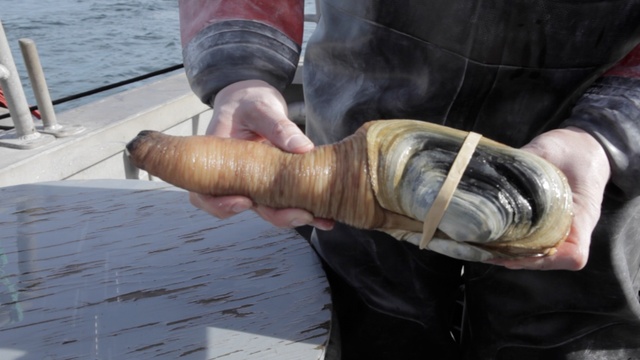
By Ashley Ahearn, KUOW
U.S. officials say they will develop a new testing protocol to detect certain contaminants in shellfish, following their meeting with the Chinese government to discuss an end to that country’s ban on importing shellfish from most of the U.S. West Coast.
Representatives of the two countries’ governments met in Beijing last week for their first face-to-face discussion of China’s shellfish ban. China banned shellfish imports in December after officials there said they found high levels of paralytic shellfish poisoning in a geoduck clam from Alaska and high levels of inorganic arsenic in a geoduck from southern Puget Sound.
U.S. officials said during a briefing with reporters Friday that the Chinese are satisfied with U.S. testing methods for paralytic shellfish poisoning but they’re still concerned about arsenic. High concentrations of inorganic arsenic, a carcinogen, were found in the skin of geoduck harvested near Tacoma, Wash., last fall.
Americans don’t eat the skin. But the Chinese often do.
The National Oceanic and Atmospheric Administration’s Paul Doremus said the U.S. will develop a new testing protocol for inorganic arsenic in shellfish.
“Ultimately it is up to China to decide whether they are satisfied that our testing mechanisms and overall protocols meets their standards,” he said.
Doremus said it was impossible to say when the ban might be lifted.
U.S. officials will meet within a week to put together the new testing protocols.
The ban has been in effect since November of 2013, costing the industry hundreds of thousands of dollars.
Court Orders Agencies To Consider Fewer Hatchery Fish For The Elwha
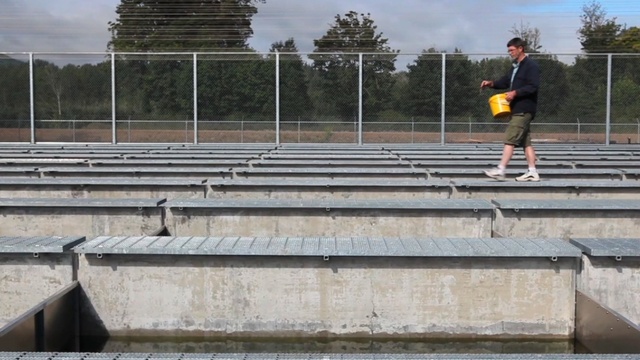
By Cassandra Profita, OPB
A judge has ordered federal agencies to reconsider the number of planned hatchery fish releases into the Elwha River on Washington’s Olympic Peninsula
As crews finish the largest dam removal in history on the Elwha, managers are working to restore fish runs above the dam sites. Their plan includes releasing more than 7 million hatchery salmon and steelhead into the river.
That plan has been controversial. Some conservation groups want to see wild fish repopulate the river on their own. They’re worried that releasing too many hatchery fish will reduce the chances of wild fish reproducing. They sued the agencies in charge of the plan as well as officials with Lower Elwha Klallam Tribe, which operates hatcheries on the river.
One of their arguments was that the agencies –- including the National Marine Fisheries Service and the National Park Service –- failed to consider options that would release fewer hatchery fish into the river.
“There was no range of alternatives,” said Kurt Beardslee, executive director of the Wild Fish Conservancy. “It was either plant all of the hatchery fish or none.”
Federal Judge Benjamin Settle agreed with that argument. He’s ordered federal agencies to meet with conservation groups to consider an option that would reduce the number of spring coho salmon and steelhead released to just 50,000 apiece. Those are the numbers conservation groups proposed.
In his opinion, the judge wrote that “the court is concerned with the spring coho and steelhead releases,” and as the agencies consider options for releasing fewer hatchery fish, those proposed numbers “would be a good starting point for an agreement.”
The National Marine Fisheries Service released a statement in response to the decision noting that the judge upheld the overall hatchery plan for the Elwha River.
“Numerous reviews and a broad consensus of scientists have found that hatcheries are necessary during dam removal to prevent the wild Elwha salmon and steelhead populations from being extinguished by sediment as the dams come down,” the statement reads. “The court upheld the Federal agencies’ decisions and the hatchery plans of the Lower Elwha Klallam Tribe on all points except one.”
Native Landslide Survivor Describes Devastating Wall of Mud; Missing Reduced to 30
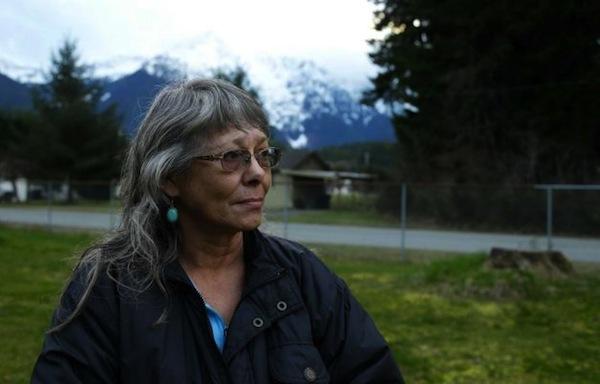
Robin Youngblood poses for a photo Thursday, March 27, 2014, with Whitehorse Mountain behind her in Darrington, Wash. Youngblood survived the massive mudslide that hit the nearby community of Oso, Wash. last Saturday, and was rescued by a helicopter as she floated on a piece of a roof.
Source: Indian Country Today Media Network
Wind and rain over the weekend have been hampering recovery efforts in the one-square-mile debris field that used to be Oso, Washington before it was obliterated by March 22’s devastating landslide.
The official count of the dead rose to 18 on Saturday March 29 as more bodies were pulled from the wreckage, but the number of missing was reduced to 30, from 90. One of the confirmed fatalities was 4-month-old Sanoah Violet Huestis, who was being babysat by her grandmother, 45-year-old Christina Jefferds. Jefferds also perished. In all, authorities had confirmed 17 dead by Friday evening March 28, though they had found several others who were not yet added to the total, pending identification.
RELATED: At Least 108 Could Be Missing in Washington State Landslide Near Sauk-Suattle Territory
Robin Tekwelus Youngblood was one of the survivors, though she lost everything except a painting. The Okanagon/Tsalagi woman was sitting in her house with a friend, she told the Associated Press, when she heard a roar that sounded like a crashing airplane, then looked out the window just in time to see a wall of mud hurtling toward her mobile home. Within seconds, it was all over.
“All I could say was ‘Oh my God’ and then it hit us,” she told AP. “Two minutes was the whole thing.”
The force of the slide tore off the roof and shoved her mobile home upward. Youngblood and the friend were able to dig out and waited about an hour for help.
Tribes have rushed in to donate personnel, money and other assistance.
RELATED: Tribes Assist Landslide Relief Effort With Personnel, Donations and Prayers
Youngblood, whose Cherokee family helped found the nearby town of Darrington in the early 1900s, is still coming to terms with the devastation. Forced out of their homelands when the Cherokee were relocated to Oklahoma and Arkansas, Youngblood’s family had kept going and moved to Washington, AP said. Youngblood moved back to the area from Hawaii, where she had been living until about two years ago.
“Several times this week I’ve said, ‘I need to go home now,’ ” she said. “Then I realize, there’s no home to go to.”
The cherished painting, named “Wolf Vision,” is of a Cherokee warrior, according to the Seattle Times. It came floating by as she clung to the wreckage of her roof, waiting for rescuers. It now is one of her few remaining possessions.
“I’m grateful to be alive,” Youngblood told AP. “I have no idea how I came out without being crushed from limb to limb.”
Read more at http://indiancountrytodaymedianetwork.com/2014/03/30/native-landslide-survivor-describes-devastating-wall-mud-missing-reduced-90-154234
Colville Tribes Plan First Hotel With Casino
“This will be our first hotel,” Mike Finley, chairman of the Colville Business Council, said. The Confederated Colville Tribes own three small casinos but no hotels. Surface preparation and some excavation for the site of the new Omak Casino Resort will begin about April 15, so cars can reach the location and people can attend the ground breaking projected for early May. The anticipated opening is about 12 months later.
Randy Williams is Director of Corporate Gaming for the tribes and he outlined details of the complex. “It’s a $43 million project. It includes a 57,000-square-foot casino and an 80-room hotel. The hotel will be between a three- and four-star hotel, so it’s upscale and will be nice. We’ll have 500 machines in this casino plus table games, two lounges and two restaurants. It will create about 200 jobs in both the casino and hotel.”
The casino/hotel will be located on reservation property south of the town of Omak, Washington. The population is quite low, but it’s only about 45 miles from the Canadian border. “We’re expecting to get a large pool from Canada, as we do now,” Finley said. “We expect some will stay longer and spend more of their disposable income as we’ll have a hotel.”
Omak Casino Resort will also be the first destination resort in Okanogan County and is expected to be an economic boon to the region as it will attract conferences.
The casino portion will be twice the size of the tribes’ Mill Bay Casino located on a trust parcel near Lake Chelan. It will also replace the tribes’ Okanogan Bingo Casino. The new casino is expected to largely employ tribal members, Finley commented.
Taylor-Woodstone Construction will oversee development; the Bloomington, Minnesota-based company has worked with a number of tribes on other casino projects, plus the huge Palazzo Casino Resort in Las Vegas, among others.
The Colville Tribal Federal Corporation is fully finnacing the project. “They’re the sole signer on the loan, and it’s the first loan the Colville Tribe has not had to guarantee. The tribes’ commitment to business development certainly has exhibited itself over the past few years.”
This area is rich in cultural history. Five years ago, ground was being broken for a $24 million casino also near Omak, but when artifacts and human remains were discovered, the project was immediately shut down. “We ordered a full archeological excavation be done in that area,” Finley said. “It turned out to be the oldest recorded archeological site on the reservation.” That location will remain undeveloped; this new hotel/casino complex is a larger version of the previous, derailed plan.
Read more at http://indiancountrytodaymedianetwork.com/2014/03/31/colville-tribes-plan-first-hotel-casino-154241
Tulalip Hibulb Cultural Center Upcoming Events
Being Frank: Put People Before Profits
By Billy Frank, Jr., Chairman, Northwest Indian Fisheries Commission
OLYMPIA – When it comes to your chances of getting cancer from the foods you eat, what odds would you like: one in a million, or one in 100,000?
Of course all of us would prefer the least amount of risk. That’s why it’s hard to believe that Gov. Jay Inslee is even considering changing water quality rules that would increase that risk. The justification? Businesses such as Boeing say that protecting your health increases their cost of doing business.
There are two important numbers that go into determining how much pollution the state allows to be put in our waters. The numbers are 10-6 and 6.5.
The first number is your cancer risk rate from eating fish and shellfish containing toxics from pollution in our waters. Right now that rate of 10-6 provides you a one in a million chance of getting cancer. But Gov. Inslee is considering changing the risk rate to 10-5, increasing your exposure to known carcinogens to one in 100,000. That’s a tenfold decrease in protection, and that’s not right.
The second number is the amount of seafood that the state of Washington says you eat every day. The lower the number, the less protective water quality standards need to be to protect us from poisons in our water.
The problem is that the state’s current rate of 6.5 grams per day (equal to about one 8-ounce portion per month) is one of the lowest fish consumption rates in the nation. It’s lower even than states like Iowa, despite the fact that Washington has abundant seafood and one of the largest populations of fish and shellfish consumers in the United States.
The state admits that the current fish consumption rate doesn’t protect most of its citizens, yet has used that very same rate to set water quality standards for more than two decades. After years of prodding by the tribes, environmental groups and others, the state has finally agreed to develop a more realistic rate and is considering a range from 125 to 225 grams per day.
While that’s encouraging, if the state adjusts the companion number, the cancer risk rate, any increase in the fish consumption rate would be made almost meaningless in terms of improved water quality standards.
The treaty tribes have been clear from the start about what we would like to see. We think the cancer risk rate should stay right where it is, and the fish consumption rate should be at least 175 grams per day. That’s the same rate that Oregon uses. We think everyone deserves at least that much protection. That’s especially true for tribes, sport fishermen and anyone else who eats a lot of fish and shellfish.
We should know Gov. Inslee’s decision on the fish consumption and cancer risk rates in a few weeks. We hope he will decide in favor of protecting our health and water quality. The choice really boils down to whether we want a pollution-based economy or one that puts people and their health ahead of profits.

